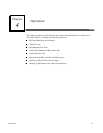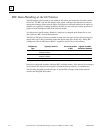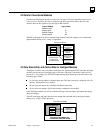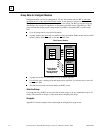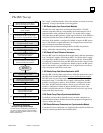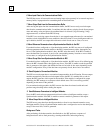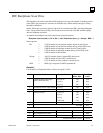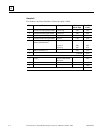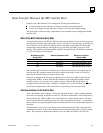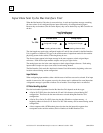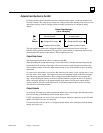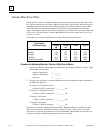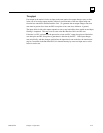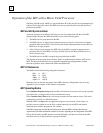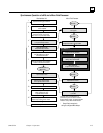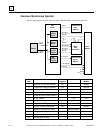
GFK-0825F Chapter 4 Operation 4-9
4
Data Transfer Between the BIU and the Host
Each bus scan, a Bus Interface Unit exchanges the following data with the host:
It sends an input message with up to 128 bytes of discrete and/or analog inputs.
It receives an output message with up to 128 bytes of discrete and/or analog outputs.
The exact length of these messages is determined by the network I/O map configured for the Bus
Interface Unit.
Data in the BIU's Network (Bus) Map
As mentioned previously, the BIU has 256 bytes of memory available for each of the four types of
data (discrete and analog inputs and outputs: I, Q, AI, and AQ). For each data type, up to half (128)
of the 256 bytes can be used for the data that will be exchanged on the Genius bus. During BIU
configuration, starting addresses and lengths are set up for each of the BIU's four types of I/O
memory. These addresses and lengths define the BIU's network I/O map. The data from each table
(I, AI, Q, and AQ) must be contiguous.
BIU Memory Type
Designation
Amount Available in BIU Maximum Length for
Network Map
I 256 bytes up to 1024 contiguous bits
Q 256 bytes up to 1024 contiguous bits
AI 256 bytes up to 64 contiguous words
AQ 256 bytes up to 64 contiguous words
Note that although it is possible to configure up to 128 bytes of memory in the network map for
each data type, the maximum amount that can be included in the map is a total of 128 bytes of
inputs (I plus AI) and 128 bytes of outputs (Q plus AQ).
Data to be exchanged on the bus must be configured to use references within the network map
configured for the BIU. Data of individual I/O modules may be configured anywhere within
available memory. It is possible to have inputs or outputs within the I/O station that are not
exchanged on the Genius bus-that is, data that is completely local to the I/O station. For example,
the I/O station might include a Micro Field Processor performing local data processing.
Communications on the Genius Bus
After a Bus Interface Unit completes a successful login with the host, it begins sending input data
on the bus and accepting output data from the bus. The BIU communicates on the bus repetitively
and asynchronously. When the BIU receives the Genius bus communications token, it sends the
most recent data from the configured portion of its I and AI memories on the bus. As mentioned,
these memories are repeatedly updated whenever the Bus Interface Unit scans the input modules in
the station.
The Bus Interface Unit receives new outputs from the host when the host's bus controller has the
communications token. It places these outputs into the configured portion of its Q and AQ output
tables. These outputs are then passed to the devices in the station on the BIU's next I/O scan.



